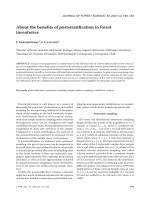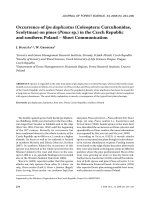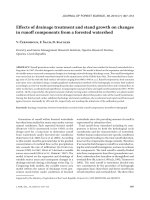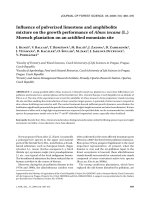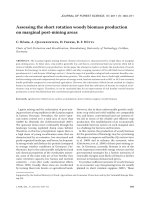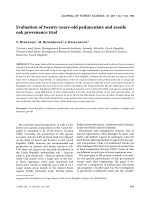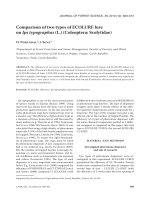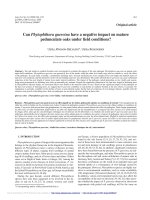Báo cáo lâm nghiệp: "Assessing the short rotation woody biomass production on marginal post-mining areas" doc
Bạn đang xem bản rút gọn của tài liệu. Xem và tải ngay bản đầy đủ của tài liệu tại đây (364 KB, 9 trang )
J. FOR. SCI., 57, 2011 (7): 303–311 303
JOURNAL OF FOREST SCIENCE, 57, 2011 (7): 303–311
Lignite mining and the reclamation of post-min-
ing areas have a long tradition in the Lusatian region
in Eastern Germany. Nowadays, the active open-
cast mines extend over a total area of more than
34,000 ha (Statistik der Kohlenwirtschaft 2007).
e opencast mines move continually through the
landscape leaving exploited dump areas behind.
erefore, in this low-precipitation region there is
a high share of young recultivation areas that are
characterized by an extensive, low-structured and
partly vegetated landscape, and hence, by frequent-
ly strong winds and distinct dry periods (compared
to average weather conditions in Germany). Fur-
thermore, due to the unfavourable soil physical and
soil chemical properties of the overburden materi-
als, most of the mine soils are of low fertility (low
water retention capacity, low humus and nutrient
contents) – even after costly amelioration efforts
(H 1996). Usually, these areas are recultivated
by turning them into forests or agricultural lands.
However, due to these unfavourable growth condi-
tions crop yield and yield stability are comparably
low, and hence, conventional land use systems of-
ten fail in terms of the reliable and efficient crop
production. e establishment of an economically
reasonable land use system on such marginal sites
is a challenge for farmers and foresters.
In this context, the production of woody biomass
for the generation of bioenergy may be a promising
alternative to improve soil fertility (Q
et al. 2009) and to enhance the economic value
(G et al. 2009) of these post-mining ar-
eas. In Germany, currently, biomass is one of the
most important renewable energy sources and the
governmental strategies for a further extension of
renewable energies most likely will lead to a further
increase in biomass demand and prices.
To produce sufficient amounts of woody biomass
in an economic way, fast-growing trees are usually
planted in short rotation coppices (SRC). ese
Supported by the Federal Ministry of Food, Agriculture and Consumer Protection and by the Vattenfall Europe Min-
ing AG.
Assessing the short rotation woody biomass production
onmarginal post-mining areas
C. B, A. Q, D. F, R. F. H
Chair of Soil Protection and Recultivation, Brandenburg University of Technology, Cottbus,
Germany
ABSTRACT: The Lusatian lignite-mining district (Eastern Germany) is characterized by a high share of marginal
post-mining areas. At these sites, crop yield is generally low, and hence, conventional land use systems often fail in
terms of reliable and efficient crop production. In this paper the attempt is made to evaluate the production of woody
biomass for bioenergy in short rotation coppices (SRC) and alley cropping systems (ACS) with black locust (Robinia
pseudoacacia L.) and lucerne (Medicago sativa L.) from the aspect of possible ecological and economic benefits com-
pared to the conventional agricultural recultivation practice. The results show that, due to both high establishment
and harvesting costs and comparatively low prices of energy wood, land use systems such as SRC or ACS are currently
hardly profitable compared to conventional agriculture. However, the cultivation of black locust resulted in a higher
humus accumulation and in a lower harvest-related nutrient export than the cultivation of lucerne as a typical recul-
tivation crop in this region. Therefore, it can be concluded that for an improvement of soil fertility woody biomass
production is more beneficial than the conventional agricultural recultivation practice.
Keywords: agroforestry; black locust; carbon accumulation; short rotation coppice; woody biomass
304 J. FOR. SCI., 57, 2011 (7): 303–311
are wood plantations where fast-growing trees are
planted at high densities and harvested in short
rotation periods of three to six years. Because the
trees are able to resprout after cutting, such planta-
tions can be utilized for more than 20 years. Alley
cropping systems (ACS) are an alternative when
crops are cultivated between hedgerows of trees
or shrubs managed as short rotation coppices.
ACS allows the combination of crop and woody
biomass production in the same field and can have
positive effects on biodiversity and microclimate
(Q et al. 2009). e latter even can
result in higher crop yields compared with conven-
tional agriculture (P et al. 1991).
However, the typical fast-growing trees used in
short rotation coppices like poplar (Populus sp.) or
willow (Salix sp.) are not suitable because of com-
parably low biomass productivity in this dry region
(G et al. 2007). By contrast, the legumi-
nous tree species black locust (Robinia pseudoaca-
cia L.) is known for its tolerance to water stress and
its ability to fix nitrogen. For that reason notewor-
thy yields are obtainable with this tree species on
marginal sites as well (B et al. 2009).
In this context, the present paper evaluates the
production of short rotation woody biomass for
bioenergy generation from the aspect of possible
ecological and economic benefits in a post-mining
area of the Lower Lusatian region. e study pre-
sented here aims to address the following specific
questions: (I) will ACS with short rotation coppice
hedgerows of black locust result in a higher crop
yield compared to conventional agriculture?; (II) is
it possible to improve soil fertility by using black
locust in SRC or ACS?; and (III) which of both land
use systems SRC and ACS has a higher economic
output compared to the conventional agricultural
recultivation practice?
MATERIAL AND METHODS
Site description
e study sites are situated in the recultivation
area of the lignite opencast mining “Welzow-Süd”
which is located in the State of Brandenburg in Ger-
many (Fig. 1). e study area is characterized by an
average annual precipitation amount of 560 mm
and mean annual temperature of 9.3°C (1951 to
2003). e substrate (mainly sands and loamy
sands) at the study site was dumped and amelio-
rated in 2004. Soil formation is in an initial stage
and the soil structure is still instable. Furthermore,
there is no groundwater influence due to the lower-
ing of the groundwater level because of the ongoing
mining activities. Substrates are characterized by a
very low content of total organic carbon (< 0.3%
at 0–30 cm soil depth), low sorption capacity and
deficient nutrient supply. More details about soil
characteristics were given by G et al.
(2009).
Data collection was carried out in an ACS es-
tablished in 2007 and in an adjacent SRC of black
locust established in 2005. e ACS comprises an
area of 7 ha and is composed of 24 m wide alleys
(corresponds to 68.6% of the total area), which are
cultivated with lucerne (Medicago sativa L.), and
11 m wide tree hedgerows (31.4%). Each hedgerow
consists of four double rows of black locust with a
plant density of 9,200 trees·ha
–1
(distance between
double rows = 1.80 m; distance between two single
rows within a double row = 0.75 m; distance be-
tween two trees within the row = 0.85 m). e same
planting layout and plant density are present in the
SRC that has a size of 12 ha. e hedgerows are
aligned in north-south orientation, across to the
prevailing wind direction (west to east).
Fig. 1. Location of the study area in the State
of Brandenburg (Germany)
J. FOR. SCI., 57, 2011 (7): 303–311 305
Soil and plant samplings
Soil samples were taken in spring 2008 and 2009
on 3 m × 15 m plots located in the centre of the
alleys as well as on 11 m × 15 m plots within the
hedgerows (each n = 8). On each plot, at least eight
soil cores were taken from a depth of 0–30 cm us-
ing a manual soil sampler (inner diameter = 2 cm)
and pooled to one composite soil sample (Fig. 2).
e aboveground biomass of lucerne was sampled
completely on three times eight plots of 1 m × 1m
in summer 2008 and 2009. ese plots were ar-
ranged at different distances from the hedgerows
(3 m away from the hedgerow on the leeward side,
at the centre of the alley and 3 m away from the
opposite hedgerow on the windward side; Fig. 2).
Woody biomass was sampled at SRC in winter 2009
after four years of growth. For this purpose, eight
randomly distributed representative trees were cut
and shredded completely.
Soil, plant and data analyses
For the determination of hot water extractable
organic carbon (HWC) and hot water extract-
able nitrogen (HWN) 10 g of air-dried fine soil
(< 2mm) was boiled in 50 ml of deionized water
for 60 min. After the extracts had cooled down at
room temperature, 2 ml of a 2N Mg
2
SO
4
solution
were added and the extracts were centrifuged at
4,000rev·min
–1
for 10 min. e concentrations of
HWC and HWN were measured in the decanted
extracts by a CN analyzer (Shimadzu). Macronu-
trients were analyzed in dried (60°C) and ground
aliquots of shredded herbaceous and woody bio-
mass. Nitrogen (N) was determined by dry com-
bustion using a CNS analyzer (Foss-Heraeus). e
determination of the elements phosphorus (P),
potassium (K), magnesium (Mg), and calcium (Ca)
was carried out by HNO
3
digestion under pressure,
according to S et al. (1993). All four ele-
ments were analyzed with an ICP-OES spectrome-
ter (ermo Scientific). Aboveground biomass was
estimated by drying the shredded plant material
at 103°C till weight constancy. Statistical analyses
were performed using the software STATISTICA
®
(StatSoft, Vers. 7). e differences between means
were tested for significance by the Mann-Whitney
U test (independent samples) or by the Wilcoxon
test (related samples).
Economic assessment
e profitability of the production of woody bio-
mass in SRC and ACS with black locust was com-
pared to the conventional agricultural recultiva-
tion practice (conventional agriculture) using the
discounted cash flow method (G et al.
2009). Costs and revenues were discounted over a
period of 24 years as an approximation of the pro-
ductive lifetime of black locust SRC. e annual val-
ues of these three land use systems (SRC, ACS and
agriculture) were calculated as annuities in Euro (€)
per hectare and per year based on the discounted
costs and revenues (B et al. 2007). For the
annual crops, average annual costs and revenues
were calculated. By doing so, it was possible to com-
pare the economic return of annual crops with that
of SRC and ACS. According to H (2002) a
discount rate of 5% was applied.
e economic assessment is based on the fol-
lowing assumptions for SRC and ACS: the rotation
period of black locust is 4 years; short rotation ar-
eas were cleared after 24 years; NPK fertilizer was
added at the beginning, P and K were added after
each harvest; short rotation areas were limed after
12 years. For conventional agriculture and ACS the
same crop rotation was assumed that starts with
twice 3 years lucerne, then 1 year winter rye (Secale
cereale L.), followed by twice 3 years lucerne and
1 year winter rye, then 1 year winter rape (Bras-
sica napus L.), 1 year winter triticale (Triticoseca-
le), 1year winter rye, 3 years lucerne, 1 year winter
rye, 1 year winter rape and 1 year winter triticale.
is crop rotation is adapted for the established re-
cultivation practice and contains an above-average
share of lucerne in the first 10–15 years. During
the first 3 years, lucerne was only mulched and re-
mained on site to improve the soil quality. Crop ar-
eas were limed after 8 and 16 years. Crop residues
remained in the field.
Figure 3
3 m
24 m 11 m
15 m
hedgerow
field
soil sampling plot
soil sampling point
lucerne sampling area
Fig. 2. Sampling scheme used at the study site of alley
cropping (samples were taken at eight sampling areas
distributed at the study site of alley cropping)
306 J. FOR. SCI., 57, 2011 (7): 303–311
An overview of costs and revenues is given in
Table 1. For ACS, 10% higher tillage costs were as-
sumed because of the field fragmentation by hedge-
rows. Otherwise, based on our own data, higher
yields by 6% in total were supposed for crops grow-
ing in ACS. In this approach, however, neither sub-
sidies nor costs of rent, transport or drying were
considered.
RESULTS AND DISCUSSION
Biomass yield
After the first rotation period (4 years of growth),
the average woody biomass yield of the black lo-
cust SRC investigated in this study amounted to
3 t·ha
–1
·year
–1
(B et al. 2009). According to
investigations by G et al. (2007, 2009)
in post-mining areas a significant increase of bio-
mass productivity can be expected for the follow-
ing rotations. ese authors reported a comparable
yield after the rotation time of 3 years, however,
after the third rotation period they determined an
annual yield of more than 7 t·ha
–1
. Hence, related
to 24years (6 rotations) an average woody biomass
yield of 6 t·ha
–1
·year
–1
can be expected for black
locust at post-mining sites described. For the in-
vestigated ACS, which has an area share of black
locust only 31.2%, a long-term average yield of
nearly 2 t·ha
–1
ACS·year
–1
can be assumed. ese
estimated or expected woody biomass yields are
relatively low compared to other sites. For example
V et al. (2002) reported yields of more than
14 t·ha
–1
·year
–1
for a SRC of black locust with the
rotation time of 5 years. Anyway, yields of black lo-
cust obtainable at the study site are high compared
with those of poplars and willows. Due to unfavour-
able growth conditions, especially due to distinct
periods of drought stress in spring and early sum-
Table 1. Production costs and revenues used to assess the economic viability of the three land use systems: short
rotation coppice, alley cropping and conventional agriculture
Costs Value Reference
Black locust (€·seedling
–1
) 0.18 local tree nursery
Planting (€·ha
–1
) 311.50 H (2009)
Seed (lucerne/rye/triticale/rape) (€·ha
–1
) 100.00/38.42/82.32/42.56 H et al. (2008)
Seed (lucerne/cereals and rape) (€·ha
–1
) 51.44/33.29 H et al. (2008)
Plough/harrow/roll/surface cultivator (€·ha
–1
) 68.49/27.08/24.34/17.93 H et al. (2008)
Fertilizer/application of pesticides (€·ha
–1
) 8.00/8.00 H et al. (2008)
Fertilizer NPK (lucerne/rye/triticale/rape) (€·ha
–1
) 96.24/105.19/219.40/167.26 H et al. (2008)
Fertilizer (N)PK (1
st
rotation/2
nd
–6
th
rotation)
(€·ha
–1
)
38.83/58.44 own data
Lime (€·ha
–1
) 16.00 H et al. (2008)
Pesticides (rye/triticale/rape) (€·ha
–1
) 20.00/58.00/66.00 H et al. (2008)
Harvest of black locust (€·t dry matter
–1
) 15.00 H (2009)
Harvest of lucerne (€·ha
–1
) 34.04 H et al. (2008)
Harvest of cereals and rape (€·ha
–1
) 62.71 H et al. (2008)
Land clearing (€·ha
–1
) 1,000.00 H (2009)
Revenues
Yield of black locust (1
st
rotation/2
nd
–6
th
rotation)
(t dry matter·ha
–1
)
3/6
B et al. (2009),
G et al. (2009)
Yield of lucerne (2 harvests·year
–1
)
(t dry matter·ha
–1
)
6.6 own data
Yields of rye/triticale/rape (t corns·ha
–1
) 3.5/3.6/2.2 H et al. (2008)
Price of black locust wood chips (€·t dry matter
–1
) 75.00/110.00
H et al. (2008),
C.A.R.M.E.N. (2010)
Price of lucerne/rye/triticale rape
(€·t dry matter/corns
–1
)
92.00/180.00/175.00/360.00
LA Sömmerda (2006),
H et al. (2008)
J. FOR. SCI., 57, 2011 (7): 303–311 307
mer, the biomass yields of these tree species range
only between < 1 t·ha
–1
·year
–1
and 4 t·ha
–1
·year
–1
at
these post-mining sites (G et al. 2009).
Additionally, crop yields are low at these mar-
ginal sites. Fig. 2 represents dry matter (DM) yields
of lucerne harvested at different distances from the
hedgerows of the ACS. e biomass yield of lucerne
varied between 1.8 t DM·ha
–1
and 2.5 t DM·ha
–1
at each harvest (two harvests per year can be expect-
ed). ese values correspond to yields of lucerne at
comparable marginal sites published by G
et al. (2007). On average, two harvests a year are pos-
sible at the study site. Hence, an annually yield of
up to 5 t DM·ha
–1
can be expected in the first years.
However, a yield increase with time is likely due to
improved soil fertility. is could also be noted in ad-
jacent fields. According to these unpublished obser-
vations an annual lucerne yield of 6.6 t DM·ha
–1
was
assumed for the economic assessment presented in
this study. Generally, crop yields varied depending on
the location within the alley. Higher yields were de-
termined on the leeward side as well as on the wind-
ward side than at the centre of the field (Fig. 3). ese
differences in biomass yield are not significant; how-
ever, a positive effect of hedgerows on the crop yield
is visible. According to Q et al. (2009)
it is most likely that hedgerows improved the micro-
climate for crops and resulted in higher water avail-
ability to the plants, especially at the peripheries of
alleys. Apparently, the positive effect of improved
microclimate, especially reduced evapotranspira-
tion due to the decreased wind velocity (B
et al. 2004), prevails over a possible competition ef-
fect between the trees and the crop. An increase of
the negative competition effect with time, such as
reported by J et al. (2000), cannot be excluded
because of the expansion of the tree roots. Current-
ly, however, the crop yield in ACS is higher than on
conventionally managed agricultural land.
Hot water extractable carbon and nitrogen
HWC and HWN represent easily decomposable
parts within soil organic carbon (TOC) and soil ni-
trogen (TN) and hence can be regarded as short-
term to medium-term available fractions of TOC
and TN (K et al. 1990; B et al. 2010).
Generally, an increase of these C and N fractions
indicates a humus accumulation process in soil.
Fig. 4 shows HWC and HWN contents one and
two years after the establishment of the ACS. Dur-
ing these years, the HWN content increased signif-
icantly (P ≤ 0.05) under hedgerow as well as under
field. By contrast, the HWC content increased sig-
nificantly (P ≤ 0.05) only under black locust. Within
the years the differences in HWC and HWN con-
tents in soil were not significant between hedge-
rows and field alleys. However, the increase of
HWC as well as of HWN was more distinct under
trees than in the soil of alleys although lucerne re-
mained on site during the first three years (Fig.4).
is indicates that the cultivation of black locust
leads to a faster and potentially higher humus ac-
cumulation in soil compared to lucerne as a typi-
cal recultivation crop. is corresponds to results
published by N-A et al. (2009), who also
found a higher C accumulation rate under short
rotation trees than under crops. Higher additions
of aboveground and belowground organic matter
may be an important reason for the higher build-
up of soil organic carbon (G et al. 2007).
Furthermore, lucerne litter has a lower potential to
generate recalcitrant humic material and hence a
higher turnover rate in soil than that of black locust
(B et al. 1995). e higher lignin content in the
litter of black locust could also be an explanation
for different HWN increases under these both N
fixing plants. Litter with a comparatively high con-
tent of lignin such as black locust may contribute to
Figure 4
Leeward side Center Windward side
Location within the alley
1.0
1.5
2.0
2.5
3.0
3.5
Yield (t DM·ha
–1
)
yield August 2008
yield June 2009
mean
standard deviation
Fig. 3. Dry biomass yields of lucerne (Med-
icago sativa L.) at the study site of alley
cropping on the leeward and windward side
of the black locust (Robinia pseudoacaciaL.)
hedgerows (each at 3 m distance from the
hedgerows) and at the centre of the 24 m
wide alleys (n = 8)
308 J. FOR. SCI., 57, 2011 (7): 303–311
a higher build-up of soil organic N and thus provide
a low but continual supply of N (B et al. 1995).
Nutrient export
Generally, the nutrient export that occurs at each
harvest must be assessed separately for each land use
system. Annual nutrient exports are common for the
conventional agriculture. By contrast, however, har-
vest-related nutrient losses occur in SRC only once
per rotation period. Moreover, the leaves of short ro-
tation trees remain on site and the nutrient content of
woody biomass is lower than that of harvested crop
(LVL 2002; Q et al. 2009). e results
presented in this study confirm the lower nutrient
export in SRC compared to conventional crops. Fig.
5 represents the nutrient export of black locust and
lucerne related to the average biomass yield of one
year (6.0 t·ha
–1
·year
–1
for black locust; 6.6 t·ha
–1
·year
-1
for lucerne). All analyzed nutrients were significantly
lower (P ≤ 0.05) in woody biomass of black locust
than in lucerne. e lowest difference between lu-
cerne and black locust was found for Ca. e export
of the other elements was more than twice higher (for
K even more than five times higher) for lucerne than
for black locust (Fig. 5). Hence, conventional agricul-
ture leads to a higher nutrient export than SRC. ACS
takes up an intermediate position depending on the
share of hedgerows. e higher the export of nutri-
ents, the more fertilizers have to be applied on the site
to maintain soil productivity. Furthermore, the need
of liming increases due to the enhanced soil acidi-
fication that is related to the higher loss of cations.
erefore, SRC, and to a lesser extent also ACS, result
in lower running costs than conventional agriculture.
is effect increases with increasing rotation periods,
because the content of nutrients bound in one weight
unit of woody biomass decreases relatively with the
increasing wood to bark ratio and thus with the in-
creasing rotation time.
Economic assessment
e economic value of SRC and ACS general-
ly increases with each rotation period due to the
high investment costs of tree seedlings and tree
Figure 5
Hedgerow Field
0
50
100
150
200
250
300
350
HWC (mg·kg
–1
)
0
3
6
9
12
15
18
21
HWN (mg·kg
–1
)
HWC 2008 HWN 2008
HWC 2009
HWN 2009
mean
standard deviation
Fig. 4. Contents of hot water extractable or-
ganic carbon (HWC) and hot water extract-
able nitrogen (HWN) in the soil of the study
site of alley cropping at a depth of 0–30 cm,
differentiated in hedgerows and in the field
(n = 8)
Figure 6
Black locust Alfalfa
0
30
60
90
120
150
180
210
Export of nutrients (kg
·ha
–1
·a
–1
)
N
Ca
Mg
P
K
mean
standard deviation
Fig. 5. Contents of nitrogen (N), calcium (Ca),
magnesium (Mg), phosphorus (P) and potas-
sium (K) in herbaceous biomass of lucerne
(alley cropping system) and woody biomass of
black locust (short rotation coppice) related
to 1 ha monoculture (n = 8)
J. FOR. SCI., 57, 2011 (7): 303–311 309
planting. Additionally, high one-time costs of land
clearing are incurred at the end of the production
period. erefore, the objective should be to use a
SRC for 20 years at least. Comparatively high har-
vesting expenses additionally raise the production
costs. is factor plays a decisive role especially in
regions with a small share of SRC or ACS because
of the lacking and thus expensive harvest technol-
ogy (P et al. 2005). Fig. 6a shows the profit-
ability of SRC and ACS in the study area compared
to conventional agriculture over a time period of
24 years using the regional average price of wood
chips. According to these calculations at least 3 ro-
tation periods are required for the positive annuity
of ACS. Even 4 rotation periods are needed for the
profitable cultivation of SRC. However, due to the
comparatively low investment costs the conven-
tional agriculture creates an income already in the
fourth year. One main determinant for the small
economic value of SRC and ACS is the low regional
price of wood chips probably due to a high wood
supply in the local market caused by the mining ac-
tivities. Across Germany, the price of wood chips
is on average about 45% higher (H et al. 2008;
C.A.R.M.E.N. 2010). If this higher price is used
for the calculations, then ACS and especially SRC
are more profitable than conventional agriculture
(Fig.6b). In this case the annuity of SRC is higher
than that of conventional agriculture already after
3 rotation periods and nearly twice as high after
24 years (Fig. 6b). According to G et al.
(2009) these findings suggest that a positive eco-
nomic impact may be achieved from the cultiva-
tion of SRC or ACS if a strategy of cultivation and
marketing is found that includes the reduction of
investment and harvesting costs and especially the
payment of appropriate prices. is seems to be
somewhat a question of time because the expan-
sion of bioenergy is planned and politically intend-
ed in Germany.
CONCLUSION
e production of woody biomass at agricultural
sites is not yet widespread in Germany. Due to the
high initial investment and high harvesting costs as
well as comparatively low prices of energy wood,
the land use systems such as SRC or ACS are cur-
rently hardly profitable compared to conventional
agriculture at marginal post-mining sites in Lower
Lusatia. However, a moderate increase of the re-
gional wood price would turn the combination of
crop and woody biomass production in ACS into
an economically advantageous land use system in
the study area despite the unfavourable growth
Fig. 6. Annuities of short rotation coppice, alley cropping and conventional agriculture calculated for the post-mining
area of the opencast mining “Welzow-Süd”; (a) price of wood chips = 75 €·t DM
–1
[average of the Brandenburg State;
H et al. (2008)] and (b) price of wood chips = 110 €·t DM
–1
[average of Germany; C.A.R.M.E.N. (2010)]; annui-
ties for each rotation period were calculated for the case of a complete failure of black locust, i.e. clearing costs were
considered at the end of each rotation period
–
600
–
450
–
300
–
150
0
150
300
Annuity (€·ha
–1
·year
–1
)
1 2 3 4 5 6
Number of rotations (rotation period = 4 years)
–600
–450
–300
–150
0
150
300
Annuity (€·ha
–1
·year
–1
)
short rotation coppice
alley cropping
(a)
(b)
conventional agriculture
310 J. FOR. SCI., 57, 2011 (7): 303–311
conditions. This is supported by the fact that the
hedgerows result in higher crop yields compared
with conventional agriculture. Regardless of the
economic assessment of the production of short
rotation biomass the cultivation of fast-growing
trees such as black locust results in higher C and
N accumulation rates in soil. Furthermore, the
low content of nutrients in woody biomass is re-
sponsible for a low nutrient export in the course
of harvest compared to the arable crop. Hence,
more nutrients remain in situ in the soil, which
has resultant beneficial effects on the soil forma-
tion processes of the overburden substrate. For
the marginal post-mining areas of Lower Lusatia
it can be concluded that black locust cultivated
in short rotation coppices contributes more to an
improvement of soil fertility than the convention-
al crop rotation.
Generally, the obvious benefits of woody biomass
production at marginal post-mining sites, such as
faster and higher humus accumulation, lower ap-
plications of fertilizers and pesticides, and also a
decrease in greenhouse gas emissions or increased
security of energy supply should be economically
valued. Otherwise, the production of woody bio-
mass need not currently be competitive with con-
ventional agriculture within the study area.
References
B A., F K H., G D., G W.,
H K U., P R., R H., S
J., S C. (2007): Kurzumtriebsplantagen auf land-
wirtschaftlichen Flächen in der Region Großenhain im
Freistaat Sachsen. Forstarchiv, 78: 95–101.
B C., Q A., F D., H R.F. (2009):
Kurzumtriebsplantage auf Niederlausitzer Rekultivier-
ungsflächen: Wachstumsverlauf von vierjährigen Robinien.
AFZ – Der Wald, 10: 532–533.
B C., L D., M F. (2010): Changes in
total and labile carbon and nitrogen contents in a sandy
soil after the conversion of a succession fallow to culti-
vated land. Journal of Soil Science and Plant Nutrition,
173: 46–54.
B J.R., H L., Z X.H. (2004): Windbreaks
in north America agricultural systems. Agroforestry Sys-
tems, 61: 65–78.
B E.L., G M.A., N P.V. (1995): Quality and
decomposition of black locust (Robinia pseudoacacia) and
alfalfa (Medicago sativa) mulch for temperate alley crop-
ping systems. Agroforestry Systems, 29: 255–264.
C.A.R.M.E.N. (2010): Preisentwicklung bei Waldhackschnit-
zeln – der Energieholz-Index. Available at http://www.
carmen-ev.de/dt/energie/bezugsquellen/ hackschnipreise.
html (accessed February 15, 2010)
G H., B B.K.V., S B.U., B O.,
K G., H R.F. (2007): Agroforestry systems for
the production of woody biomass for energy transforma-
tion purposes. Ecological Engineering, 29: 319–328.
G H., B C., Q A., G
P., E J., . W G. (2009): Robinia pseudoaca-
cia L.: A lesser known tree species for biomass production.
Bioenergy Research, 2: 123–133.
H K. (1996): Recultivation in the Lusatian mining region
– targets and prospects. Water, Air and Soil Pollution, 91:
43–57.
H H., N G., B H. (2008): Datensammlung
für die Betriebsplanung und die betriebswirtschaftliche
Bewertung landwirtschaftlicher Produktionsverfahren im
Land Brandenburg. Schriftenreihe des Landesamtes für
Verbraucherschutz, Landwirtschaft und Flurneuordnung
(LVLF), Potsdam.
H H. (2002): Kosten der Energiegewinnung aus
Biomasse. In: H H., K M. (eds):
Biomasse als erneuerbarer Energieträger. Schriftenreihe
Nachwachsende Rohstoffe, 3: 486–527.
H M. (2009): Energieholzproduktion in der Land-
wirtschaft. Fachagentur Nachwachsende Rohstoffe e.V.
(FNR), Gülzow.
J S., G A.R., S J.R., B D.J. (2000):
Defining competition vectors in a temperate alley cropping
system in the midwestern USA: 2. Competition for water.
Agroforestry Systems, 48: 41–59.
K M., S E., B R. (1990): Hot water
extractable carbon and nitrogen of soils as a criterion for
their ability of N-release. Zentralblatt für Mikrobiologie,
145: 305–311.
LA Sömmerda (Landwirtschaftsamt Sömmerda) (2006):
Richtsätze für Aufwuchsschäden an landwirtschaftlichen
Kulturen im Freistaat Thüringen. Landwirtschaftsamt
Sömmerda, Sömmerda.
LVL (Landesamt für Verbraucherschutz und Landwirtschaft)
(2002): Umsetzung der Düngeverordnung – Nährstoffver-
gleiche im Land Brandenburg 2002. Informationen aus dem
Referat Acker- und Pflanzenbau, Güterfelde.
N-A S., G H., F D., H R.F.,
D O. (2009): Microbial activity, organic C accumulation
and
13
C abundance in soils under alley cropping systems
after 9 years of recultivation of quaternary deposits. Biol-
ogy and Fertility of Soils, 45: 531–538.
P G., B T., H-M K. (2005): Schnell-
wachsende Baumarten – Chance für zusätzliches Einkom-
men im ländlichen Raum? In: Paper, AAEA Annual Meet-
ing, July 24–27, 2005, Providence, Rhode Island. Discussion
Paper 2005.
P M., B G., K H. (1991): Effects of
shelterbelts on crop yield. Feldwirtschaft, 32: 229–231.
J. FOR. SCI., 57, 2011 (7): 303–311 311
Q A., W J., B C., G H.,
F D., S B.U., H R.F. (2009): Ecologi-
cal benefits of the agroforestry-system Alley Cropping in
sensitive regions of Europe. Environmental Science and
Policy, 12: 1112–1121.
S P., X L., K G., M M. (1993):
Multi-elemental analysis in biological samples by on-line
preconcentration on 8-hydroxyquinoline-cellulose mi-
crocolumn coupled to simultaneous ICP-AES. Fresenius
Journal of Analytical Chemistry, 345: 600–606.
Statistik der Kohlenwirtschaft (2007): Der Kohlenbergbau in
der Energiewirtschaft der Bundesrepublik Deutschland im
Jahre 2006. Statistik der Kohlenwirtschaft e.V., Köln, Essen.
V A., W A., R G. (2002): Leitlinie zur
effizienten und umweltverträglichen Erzeugung von Ener-
gieholz. üringer Landesanstalt für Landwirtschaft, Jena.
Received for publication September 19, 2010
Accepted after corrections March 21, 2011
Corresponding author:
Dr. C B, Brandenburg University of Technology, Chair of Soil Protection and Recultivation,
Konrad-Wachsmann-Allee 6, D 03046 Cottbus, Germany
e-mail:
